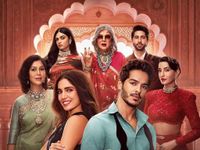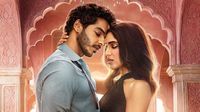Netflix India’s latest original, The Royals, promised grandeur, intrigue, and slow-burn romance set against the crumbling majesty of a fictional Rajasthani palace. However, early viewers have found the eight-episode series to be an underwhelming affair, filled with clichés, clunky dialogue, and a surprising lack of emotional heft. The show stars Ishaan Khatter as Aviraaj, a reluctant prince, and Bhumi Pednekar as Sophia, an ambitious entrepreneur aiming to transform the royal palace into a luxury homestay called The Royal B&B.
The narrative centers on Aviraaj, who unexpectedly inherits the title of Maharaj of Morpur following his father’s death. Unlike his brother Digvijay, who embraces royal responsibilities, Aviraaj is less than thrilled about his new role. Financial struggles within the royal family force him to assist Sophia with her project, which seeks to allow commoners a taste of royal life.
Despite the promising premise, the chemistry between Khatter and Pednekar has been widely criticized. Viewers have taken to social media to express their disappointment, with one user stating, "Bhumi and Ishaan have zero chemistry, and the royal women look more like gujju bens than Rajput matriarchs. Bore!" Another user was more scathing: "Who greenlights garbage like The Royals? Netflix India’s entire content team should be sacked." This sentiment reflects a broader frustration with the show’s lack of depth and engaging storytelling.
The supporting cast includes notable actors such as Milind Soman, who plays Yuvanath, Aviraaj’s late father, and Zeenat Aman as his grandmother. Sakshi Tanwar portrays Rani Maa, Aviraaj’s mother, while Dino Morea plays Maharaja Salauddin. Despite the star-studded lineup, many viewers feel that the performances are hampered by the weak script and lack of character development.
Critics have pointed out that while the visuals are stunning—showcasing ornate palaces and elaborate costumes—the narrative fails to deliver a compelling story. The Morpur royal family, mired in debt, is depicted as considering the transformation of their palace into a luxury homestay, which could have been an interesting exploration of the conflict between tradition and modernity. Unfortunately, this potential is buried under clunky exposition and inconsistent tone.
One review notes, "The Royals is all pomp and no punch—another forgettable entry in Netflix India’s long list of misfires." This highlights the growing concern among Netflix viewers regarding the quality of homegrown content. As the audience becomes more vocal about their expectations, The Royals serves as a reminder that no amount of costume drama can mask the absence of solid storytelling.
The romantic plot between Aviraaj and Sophia is meant to be the driving force of the series, yet it often feels forced and unconvincing. As they navigate their relationship, complications arise with the return of their ex-partners—Sophia’s former partner Kunal and Aviraaj’s ex Ayesha. The tension between their pasts and their budding romance adds a layer of complexity, but viewers remain skeptical about whether the couple will ultimately find happiness together.
Furthermore, the show attempts to address contemporary themes such as entrepreneurship and financial responsibility through Sophia’s character, who is labeled "impulsive" by both her boss and her competitor. Her ambition to make the faltering princely estates financially viable is admirable, yet the execution of this storyline leaves much to be desired.
As the series progresses, the royal family’s struggles with their lavish lifestyle become apparent. The young maharaja, burdened by the expectations of his title, often expresses his dissatisfaction, stating, "The more I give to the palace, the more it wants from me." This sentiment resonates with audiences who may find parallels in their own lives, balancing personal desires with societal expectations.
Despite its lavish production design and the allure of royal life, many viewers feel that The Royals falls short of its potential. One YouTube reviewer humorously remarked that there seemed to be more chemistry between Ishaan’s character and his horse than between the leads. Such critiques underscore the show’s struggle to find a balance between style and substance.
In the current climate, where audiences are inundated with various streaming options, The Royals may struggle to capture and retain viewer interest. As the country grapples with pressing issues, including a preoccupation with war, the frivolity of a royal romance may feel out of touch. The show’s attempt to provide a distraction from reality is commendable, yet it remains to be seen whether it can hold viewers’ attention long enough to make a lasting impact.
As audiences continue to voice their opinions online, the future of The Royals hangs in the balance. With a mix of criticisms and praise, Netflix faces the challenge of delivering content that meets the expectations of its diverse viewer base. Whether The Royals will find its footing in the crowded landscape of streaming remains uncertain, but one thing is clear: strong performances and lavish settings alone are not enough to guarantee success.
In conclusion, The Royals serves as a reminder that while the promise of a royal romance may attract viewers, it is the strength of the storytelling and character development that ultimately keeps them engaged. As Netflix continues to explore new narratives, the lessons learned from this series could shape the future of its original content.






